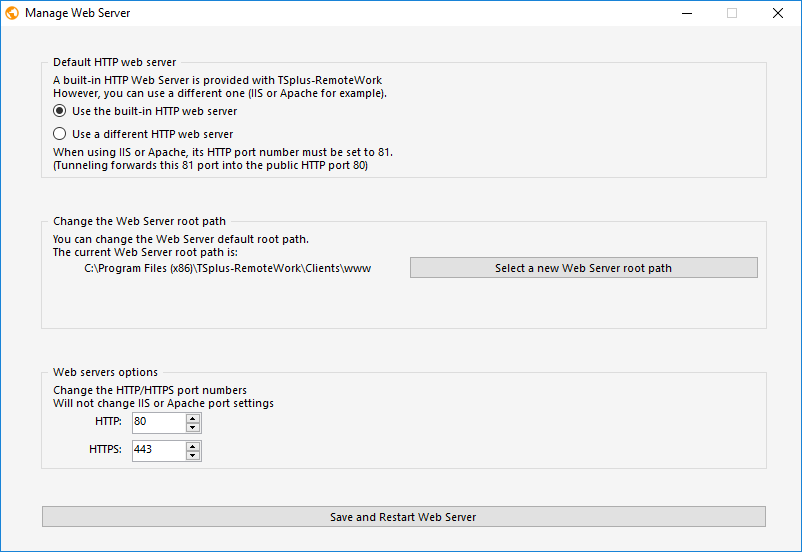Server Management
Changing the RDP port number and setting up the firewall
With the AdminTool, you can select a different TCP/IP port number for the RDP service to accept connections on. The default one is 3389. You can choose any arbitrary port, assuming that it is not already used on your network and that you set the same port number on your firewalls and on each remote-work user access programs.
Remote Work includes a unique port forwarding and tunneling capability: regardless the RDP port that has been set, the RDP will also be available on the HTTP and on the HTTPS port number!
If users want to access your remote-work server outside from your network, you must ensure all incoming connections on the port chosen are forwarded to the remote-work server.
Your Remote Desktop Server must be available, easy-to-access and safe. That’s why Remote Work utilizes a built-in Web Server which helps you easily manage its status and operations.
A Management Console is available in the Administrator Tool.
This Management Console enables you to view and configure the status of Terminal Service Plus built-in Web Server.
When you install Remote Work, web servers are listening on ports 80 and 443 by default.
Make sure that the defined ports are available and that Java is installed on the server.
Web Server Components Status
The status of the Web Server main components are displayed on the AdminTool Home dashboard.

Ports Considerations (Local Machine and Firewall / Router)
Remote Work only requires either Port 80 or Port 443 to be opened.
Port 3389 can stay closed.
Restart / Stop the Web Server Service
If you see that a service is not running, you may need to restart the Web servers by clicking on the "Restart Web Servers button" which is represented by an arrow on the right, the Web Servers will be restarted and the service should be running again.

If you click on the "Stop Web Servers" button, placed on the middle, the Web servers will be stopped.
The HTTP and HTTPS server status will now display in red indicating that the HTTP / HTTPS services are stopped:

Manage Web Servers

You can change the ports during installation or at any time by clicking on the Web - Web Server tab. On this tab, you can choose to use a different HTTP web server, modify the Web Server root path and the HTTP/HTTPS port numbers. Make sure that these ports are available before changing them: if a conflict occur Remote Work web server will not work. Here is a non-exhaustive list of TCP port that might be used by an application on your server. Once these modifications done, click on save and the AdminTool will restart.